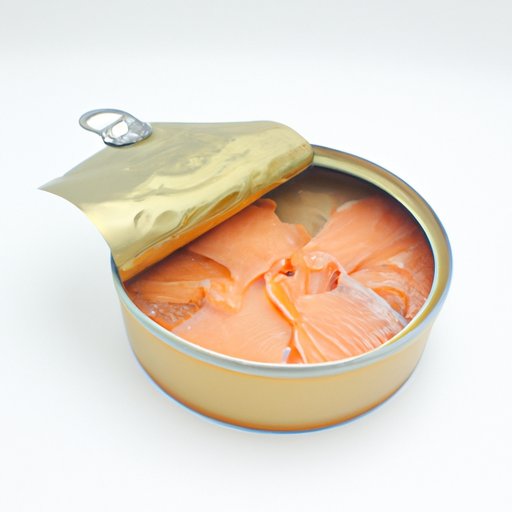Introduction
Canned salmon is gaining popularity as a tasty and easy-to-use food option that provides numerous health benefits. Not only is it convenient, but it is also an affordable and delicious way to add essential vitamins, minerals, and healthy nutrients to your diet. In this article, we will explore all the nutritional benefits of canned salmon and how to incorporate it into your meals for a healthier you.
A Comprehensive Guide to the Nutritional Benefits of Canned Salmon
Canned salmon is an excellent source of protein and omega-3 fatty acids, which your body needs for many functions, such as building muscle and reducing inflammation. Just one serving (three ounces) of canned salmon contains around 17 grams of protein, all nine essential amino acids, and 1.5 grams of omega-3 fatty acids. Additionally, canned salmon is a low-calorie and low-fat food that can help in weight loss efforts.
In addition to protein and omega-3s, canned salmon is also rich in vitamins and minerals, including calcium, iron, potassium, vitamin A, and vitamin D. Calcium is crucial for strong bones and teeth, while iron is essential for healthy blood flow. Potassium helps to regulate blood pressure levels, and vitamin A and D boost immune function.
Studies show that consuming canned salmon regularly can also reduce the risk of heart disease and stroke, thanks to the omega-3 fatty acids it provides. Omega-3s have anti-inflammatory properties that can reduce inflammation in the body, which is a precursor for many chronic diseases.
How to Incorporate Canned Salmon in your Diet
Incorporating canned salmon into your diet is easy and convenient. It is perfect for busy nights when you need a quick and healthy meal. Here are a few suggestions and recipes for incorporating canned salmon into your everyday meals:
– Mix canned salmon with mayonnaise, mustard, and diced celery for a delicious salmon salad to have over greens, crackers, or on sandwiches.
– Toss canned salmon with cooked quinoa, veggies, and a homemade dressing for a quick and healthy lunch bowl.
– Make salmon cakes by mixing canned salmon with breadcrumbs, egg, and spices and baking them in the oven or sautéing in a pan.
– Add canned salmon to scrambled eggs, frittatas, or omelets for a protein-packed breakfast.
– Use canned salmon to top a salad with some roasted veggies and a homemade dressing.
The Differences between Wild and Farmed Canned Salmon
There are nutritional differences between wild and farmed canned salmon, primarily due to their diets. Wild salmon, which feed on algae and other fish, are typically leaner and have a higher concentration of omega-3 fatty acids. In contrast, farmed salmon, which are fed fishmeal and other supplements, have a higher fat content and, subsequently, fewer omega-3s. It is important to note that farmed salmon often contain more environmental contaminants than wild salmon, which may impact your health.
When choosing between wild and farmed salmon, it is essential to consider the nutritional benefits as well as the environmental impact of the product. Seek sources that adhere to sustainability standards, as well as those that avoid environmental contaminants.
Choosing the Best Canned Salmon
When choosing canned salmon, look for labels that indicate the contents’ ingredients and nutritional value. The most desirable canned salmon is those without extra salt, sugar, and preservatives. There are different types of canned salmon available on the market, including boneless or skinless, and some brands offer flavors such as lemon and dill. Choose canning methods that retain the maximum nutritional value by avoiding those using high temperatures that degrade nutrients.
Canned Salmon vs. Other Forms of Salmon
Canned salmon is a versatile and delicious form of salmon that is also very nutritious. Compared to fresh, frozen, and smoked salmon options, canned salmon is often more affordable and accessible, making it a great option for regular consumption. Although there are some differences in the nutrient content, canned salmon remains a highly nutritious form of the fish.
The Health Benefits of Eating Canned Salmon for Breakfast
Eating canned salmon for breakfast can give you a boost of energy and provide many essential nutrients that your body needs. Incorporating its high protein content into your morning meal can help you feel fuller for longer and reduce snacking on unhealthy options later.
Here are some ideas and recipes for breakfast dishes that use canned salmon:
– Spread mashed avocado over whole-grain toast and top with canned salmon for a delicious and filling breakfast
– Add canned salmon to your morning smoothie or juice to have a protein-packed beverage to start the day
– Make a salmon breakfast bowl with cooked quinoa, roasted veggies, and an over-easy egg for a portable and nutritious breakfast option
Conclusion
Canned salmon is an excellent choice for people looking for a healthy and convenient food option. Its high protein content, omega-3 fatty acids, and other essential vitamins and minerals make it a nutritious addition to any meal. By choosing high-quality canned salmon that adheres to sustainability standards, you can prioritize your health and health of the planet. Try incorporating canned salmon in your meals today and reap the benefits of this tasty and nutritious food option.
(Note: Is this article not meeting your expectations? Do you have knowledge or insights to share? Unlock new opportunities and expand your reach by joining our authors team. Click Registration to join us and share your expertise with our readers.)
